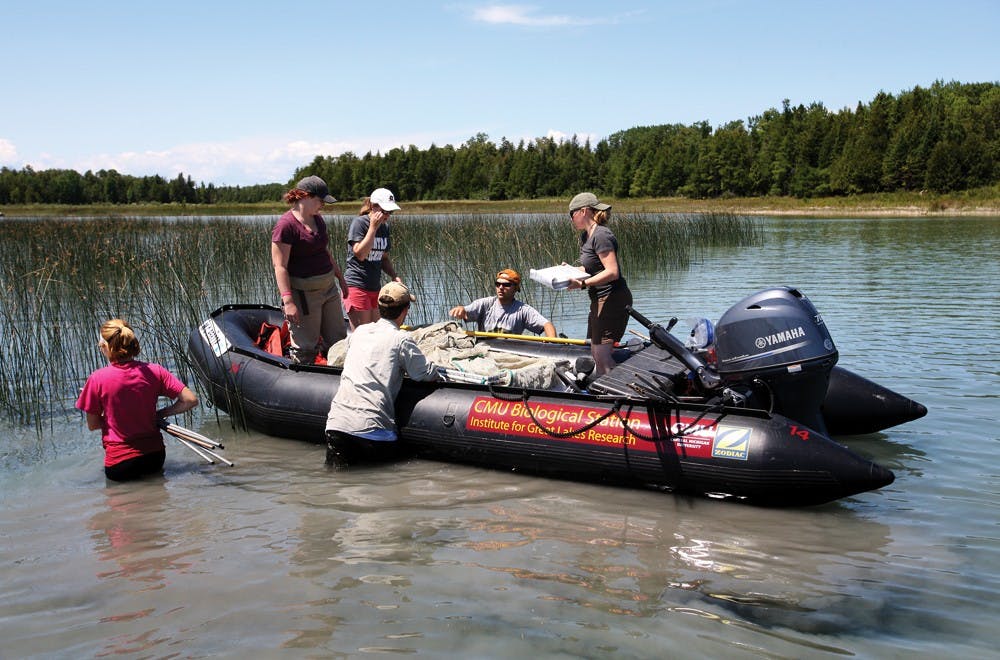Institute for Great Lakes Research progress threatened by White House U.S. budget proposal

The “Budget Blueprint to Make America Great Again” released on March 13 by President Donald Trump could affect 1.5 million jobs provided by the Great Lakes Restoration Initiative — including positions at Central Michigan University.
The Great Lakes Restoration Initiative was started in 2010 to clean up and preserve the Great Lakes. Students and researchers at the Institute for Great Lakes Research monitor coastal wetlands to ensure people have access to safe drinking water and to make sure pollutants and harmful toxins are kept out of the Great Lakes.
The GRLI was granted $300 million from 2010-2015 by the U.S. Environmental Protection Agency, the amount was reduced by $50 million in 2016. The 2018 draft of the national budget slashes the Great Lakes Restoration Initiative by 97 percent.
CMU is one of 12 universities partnered with the IGLR. CMU heads the initiative and focuses on cleaning up toxics and areas of concern, combating invasive species, promoting nearshore health by protecting water sheds from polluted run-off and restoring wetlands and other habitats.
"CMU Institute for Great Lakes Research certainly has had quite a bit of Great Lakes Restoration Initiative funds since 2010 so if GLRI was eliminated it would result in decreased funding for the Great Lakes in general, and therefore, a decrease in funding for CMU IGLR," said Donald Uzarski, director of the Institute for Great Lakes Research at CMU.
There are roughly 80 graduate students and technicians, 24 faculty members and two post-doc positions at the Institute for Great Lakes Research at Central Michigan University that would also be threatened. Many of the graduate students and technicians are funded on grants.
“It’s scary to think that all of the work we've been doing so far has the potential to come to an end just like that,” Sasha Bozimowski, a wetland technician for the Institute for Great Lakes Research said. “It’s even scarier to me as a lab manager knowing that there are graduate and undergraduate students that have their schooling, which is funded through these grants, being threatened.”
The president's proposal would eliminate all Great Lakes protection programs run by the Environmental Protection Agency, including a $20 million project headed by Uzarski.
Uzaraski said with the decrease in funding the institute will not be able to turnover the amount of graduate assistant it hires every year.
The institute was granted the funds in 2010 by the Great Lakes Restoration Initiative which was formed in 2010. The initiative was launched to accelerate efforts to protect and restore the largest system of fresh surface water in the world –– the Great Lakes.
“I think the ($250 million) the Great Lakes Restoration Initiative receives every year will be reduced, but I don’t think it will be cut entirely,” Uzarski said. “We (at CMU) are going to probably feel the pain. Any budget cut is going to trickle down to any of the projects that are funded through it.”
However, Uzarski said if the budget cuts occur it will not mean an end to the IGLR at CMU.
"Ultimately, the general public will begin to see the impacts first hand, and then they will demand funding returns," he said.
The 2018 draft of the national budget slashes the Great Lakes Restoration Initiative by 97 percent, stating environmental responsibility should be handed over to the states which govern them.
“Handing off the responsibility to individual states becomes problematic when you’re dealing (with) an ecosystem as large as the Great Lakes," Donald Uzarski said. "We’re looking at two provinces and eight states that don’t always agree with one another. There needs to be a higher oversight of the Great Lakes because of the all the political borders it involves.”
The Obama administration granted the GLRI $300 million, the largest national investment in the Great Lakes in over two decades, for five years according to a press release from the U.S. EPA.
The GLRI has funded more than 2,900 projects in Minnesota, Michigan, Ohio, Wisconsin, Illinois, New York, Indiana and Pennsylvania to restore fish and wildlife habitat, clean up toxics, prevent the spread of invasive species such as Asian Carp and restoring and monitoring wetlands.
Sean Hammond, deputy director at Michigan Environmental Council, said GLRI has provided crucial progress to the restoration and protection of vital coastal wetlands in the Great Lakes region.
“Because the Great Lakes Restoration Initiative is a bipartisan issue, we’re hoping these agencies are able keep their funding after review,” Hammond said.
Uzarski agreed, saying the Great Lakes are critical to the region's economy.
“Our tourism and fishing industry is based on the Great Lakes," he said. "It doesn’t matter whether you’re a republican or democrat, you don’t want to see that go away.”
The commercial fishery in the Great Lakes region is worth $7.5 billion per year. According to the fishery industry alone provides 8 million jobs.
“It’s very difficult to make that partisan,” he said.
The amount granted to the Great Lakes Restoration Initiative was reduced to $250 million in 2016.
Bozimowski started working for IGLR in 2011 as a lab technician. She said she believes defunding programs like the GLRI occurs because people have misconceptions toward research.
“I don’t think many people understand the importance of research,” she said. “They might look at us and think we’re just cleaning a pond up but we're doing so much more than that."
When environmental research is defunded more than just the environment begins to suffer, Bozimowski said. Devaluing the research means issues like algal blooms will occur.
An algal bloom is a rapid increase or accumulation in the population of algae in freshwater or marine water systems. They can be brown, neon green, or blue-green, and can be smelly, slimy and even poisonous.
In 2014, nearly 500,000 people were cut off from accessing clean drinking water in Toronto, Canada after a toxic algae bloom contaminated the water source. Ingested water from an agal bloom can lead to gastrointestinal discomfort, and in very rare cases acute liver failure.
According to U.S. EPA, GLRI also works with farmers in the region to prevent polluted runoff which often causes algae blooms.
Hammond said he hopes states outside of the region are able to understand the importance of maintaining the quality of the Great Lakes.
“This funding provides opportunities to protect our shared waters, which is the largest region of fresh surface water in the world,” he said.
Bozimowski said she and the students she works with are remaining hopeful, but preparing for the worst. Uzarski said it isn’t abnormal for student in the environmental sciences to feel a little uneasy.
“The students in the sciences feel as though they’ve been let down,” he said. “In my lab, the students I work with directly, I tell them it’s not time to panic. What I see potentially happening politically is it reminds people of how important this stuff is. It can actually create a lot of momentum in the opposite direction.”



